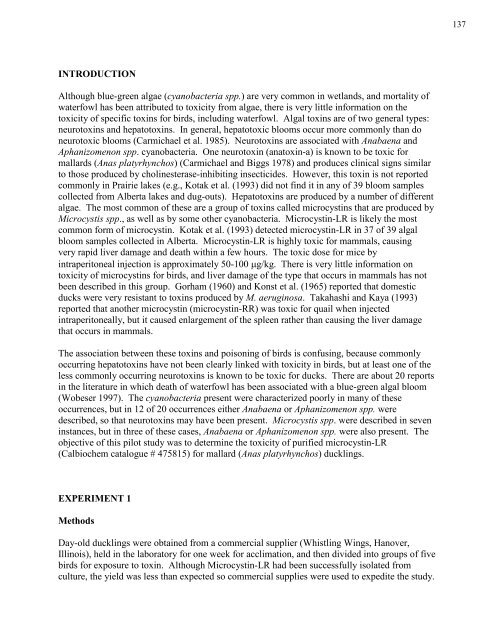Ecology and Management of Avian Botulism on the Canadian Prairies
Ecology and Management of Avian Botulism on the Canadian Prairies
Ecology and Management of Avian Botulism on the Canadian Prairies
You also want an ePaper? Increase the reach of your titles
YUMPU automatically turns print PDFs into web optimized ePapers that Google loves.
137INTRODUCTIONAlthough blue-green algae (cyanobacteria spp.) are very comm<strong>on</strong> in wetl<str<strong>on</strong>g>and</str<strong>on</strong>g>s, <str<strong>on</strong>g>and</str<strong>on</strong>g> mortality <str<strong>on</strong>g>of</str<strong>on</strong>g>waterfowl has been attributed to toxicity from algae, <strong>the</strong>re is very little informati<strong>on</strong> <strong>on</strong> <strong>the</strong>toxicity <str<strong>on</strong>g>of</str<strong>on</strong>g> specific toxins for birds, including waterfowl. Algal toxins are <str<strong>on</strong>g>of</str<strong>on</strong>g> two general types:neurotoxins <str<strong>on</strong>g>and</str<strong>on</strong>g> hepatotoxins. In general, hepatotoxic blooms occur more comm<strong>on</strong>ly than d<strong>on</strong>eurotoxic blooms (Carmichael et al. 1985). Neurotoxins are associated with Anabaena <str<strong>on</strong>g>and</str<strong>on</strong>g>Aphanizomen<strong>on</strong> spp. cyanobacteria. One neurotoxin (anatoxin-a) is known to be toxic formallards (Anas platyrhynchos) (Carmichael <str<strong>on</strong>g>and</str<strong>on</strong>g> Biggs 1978) <str<strong>on</strong>g>and</str<strong>on</strong>g> produces clinical signs similarto those produced by cholinesterase-inhibiting insecticides. However, this toxin is not reportedcomm<strong>on</strong>ly in Prairie lakes (e.g., Kotak et al. (1993) did not find it in any <str<strong>on</strong>g>of</str<strong>on</strong>g> 39 bloom samplescollected from Alberta lakes <str<strong>on</strong>g>and</str<strong>on</strong>g> dug-outs). Hepatotoxins are produced by a number <str<strong>on</strong>g>of</str<strong>on</strong>g> differentalgae. The most comm<strong>on</strong> <str<strong>on</strong>g>of</str<strong>on</strong>g> <strong>the</strong>se are a group <str<strong>on</strong>g>of</str<strong>on</strong>g> toxins called microcystins that are produced byMicrocystis spp., as well as by some o<strong>the</strong>r cyanobacteria. Microcystin-LR is likely <strong>the</strong> mostcomm<strong>on</strong> form <str<strong>on</strong>g>of</str<strong>on</strong>g> microcystin. Kotak et al. (1993) detected microcystin-LR in 37 <str<strong>on</strong>g>of</str<strong>on</strong>g> 39 algalbloom samples collected in Alberta. Microcystin-LR is highly toxic for mammals, causingvery rapid liver damage <str<strong>on</strong>g>and</str<strong>on</strong>g> death within a few hours. The toxic dose for mice byintraperit<strong>on</strong>eal injecti<strong>on</strong> is approximately 50-100 µg/kg. There is very little informati<strong>on</strong> <strong>on</strong>toxicity <str<strong>on</strong>g>of</str<strong>on</strong>g> microcystins for birds, <str<strong>on</strong>g>and</str<strong>on</strong>g> liver damage <str<strong>on</strong>g>of</str<strong>on</strong>g> <strong>the</strong> type that occurs in mammals has notbeen described in this group. Gorham (1960) <str<strong>on</strong>g>and</str<strong>on</strong>g> K<strong>on</strong>st et al. (1965) reported that domesticducks were very resistant to toxins produced by M. aeruginosa. Takahashi <str<strong>on</strong>g>and</str<strong>on</strong>g> Kaya (1993)reported that ano<strong>the</strong>r microcystin (microcystin-RR) was toxic for quail when injectedintraperit<strong>on</strong>eally, but it caused enlargement <str<strong>on</strong>g>of</str<strong>on</strong>g> <strong>the</strong> spleen ra<strong>the</strong>r than causing <strong>the</strong> liver damagethat occurs in mammals.The associati<strong>on</strong> between <strong>the</strong>se toxins <str<strong>on</strong>g>and</str<strong>on</strong>g> pois<strong>on</strong>ing <str<strong>on</strong>g>of</str<strong>on</strong>g> birds is c<strong>on</strong>fusing, because comm<strong>on</strong>lyoccurring hepatotoxins have not been clearly linked with toxicity in birds, but at least <strong>on</strong>e <str<strong>on</strong>g>of</str<strong>on</strong>g> <strong>the</strong>less comm<strong>on</strong>ly occurring neurotoxins is known to be toxic for ducks. There are about 20 reportsin <strong>the</strong> literature in which death <str<strong>on</strong>g>of</str<strong>on</strong>g> waterfowl has been associated with a blue-green algal bloom(Wobeser 1997). The cyanobacteria present were characterized poorly in many <str<strong>on</strong>g>of</str<strong>on</strong>g> <strong>the</strong>seoccurrences, but in 12 <str<strong>on</strong>g>of</str<strong>on</strong>g> 20 occurrences ei<strong>the</strong>r Anabaena or Aphanizomen<strong>on</strong> spp. weredescribed, so that neurotoxins may have been present. Microcystis spp. were described in seveninstances, but in three <str<strong>on</strong>g>of</str<strong>on</strong>g> <strong>the</strong>se cases, Anabaena or Aphanizomen<strong>on</strong> spp. were also present. Theobjective <str<strong>on</strong>g>of</str<strong>on</strong>g> this pilot study was to determine <strong>the</strong> toxicity <str<strong>on</strong>g>of</str<strong>on</strong>g> purified microcystin-LR(Calbiochem catalogue # 475815) for mallard (Anas platyrhynchos) ducklings.EXPERIMENT 1MethodsDay-old ducklings were obtained from a commercial supplier (Whistling Wings, Hanover,Illinois), held in <strong>the</strong> laboratory for <strong>on</strong>e week for acclimati<strong>on</strong>, <str<strong>on</strong>g>and</str<strong>on</strong>g> <strong>the</strong>n divided into groups <str<strong>on</strong>g>of</str<strong>on</strong>g> fivebirds for exposure to toxin. Although Microcystin-LR had been successfully isolated fromculture, <strong>the</strong> yield was less than expected so commercial supplies were used to expedite <strong>the</strong> study.


